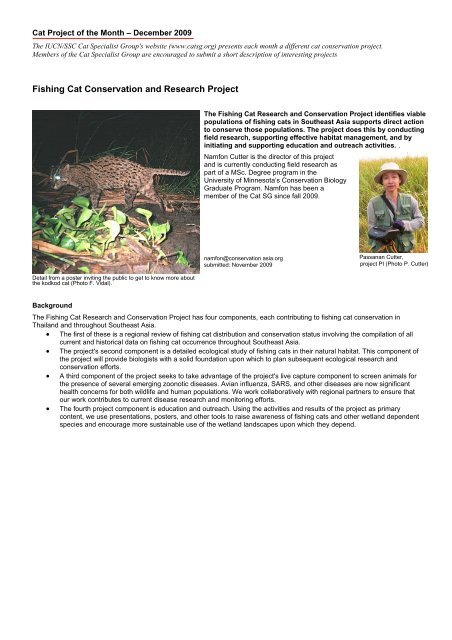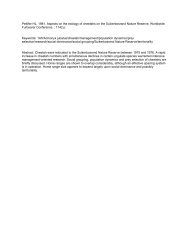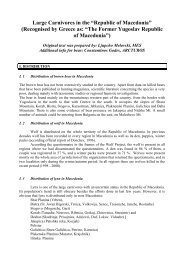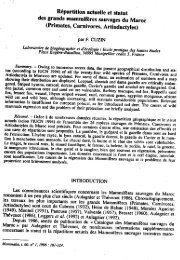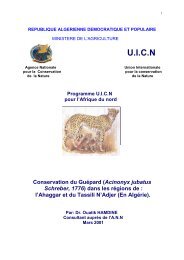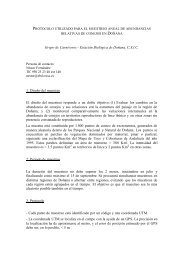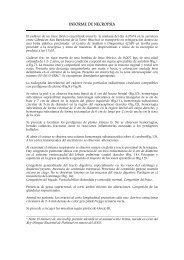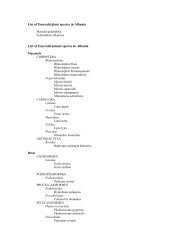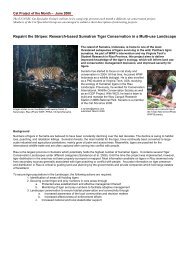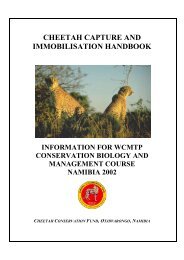Fishing Cat Conservation and Research Project - Cat Specialist Group
Fishing Cat Conservation and Research Project - Cat Specialist Group
Fishing Cat Conservation and Research Project - Cat Specialist Group
You also want an ePaper? Increase the reach of your titles
YUMPU automatically turns print PDFs into web optimized ePapers that Google loves.
<strong>Cat</strong> <strong>Project</strong> of the Month – December 2009<br />
The IUCN/SSC <strong>Cat</strong> <strong>Specialist</strong> <strong>Group</strong>'s website (www.catsg.org) presents each month a different cat conservation project.<br />
Members of the <strong>Cat</strong> <strong>Specialist</strong> <strong>Group</strong> are encouraged to submit a short description of interesting projects<br />
<strong>Fishing</strong> <strong>Cat</strong> <strong>Conservation</strong> <strong>and</strong> <strong>Research</strong> <strong>Project</strong><br />
Detail from a poster inviting the public to get to know more about<br />
the kodkod cat (Photo F. Vidal).<br />
Background<br />
The <strong>Fishing</strong> <strong>Cat</strong> <strong>Research</strong> <strong>and</strong> <strong>Conservation</strong> <strong>Project</strong> identifies viable<br />
populations of fishing cats in Southeast Asia supports direct action<br />
to conserve those populations. The project does this by conducting<br />
field research, supporting effective habitat management, <strong>and</strong> by<br />
initiating <strong>and</strong> supporting education <strong>and</strong> outreach activities. .<br />
Namfon Cutter is the director of this project<br />
<strong>and</strong> is currently conducting field research as<br />
part of a MSc. Degree program in the<br />
University of Minnesota’s <strong>Conservation</strong> Biology<br />
Graduate Program. Namfon has been a<br />
member of the <strong>Cat</strong> SG since fall 2009.<br />
namfon@conservation asia.org<br />
submitted: November 2009<br />
Passanan Cutter,<br />
project PI (Photo P. Cutter)<br />
The <strong>Fishing</strong> <strong>Cat</strong> <strong>Research</strong> <strong>and</strong> <strong>Conservation</strong> <strong>Project</strong> has four components, each contributing to fishing cat conservation in<br />
Thail<strong>and</strong> <strong>and</strong> throughout Southeast Asia.<br />
• The first of these is a regional review of fishing cat distribution <strong>and</strong> conservation status involving the compilation of all<br />
current <strong>and</strong> historical data on fishing cat occurrence throughout Southeast Asia.<br />
• The project's second component is a detailed ecological study of fishing cats in their natural habitat. This component of<br />
the project will provide biologists with a solid foundation upon which to plan subsequent ecological research <strong>and</strong><br />
conservation efforts.<br />
• A third component of the project seeks to take advantage of the project's live capture component to screen animals for<br />
the presence of several emerging zoonotic diseases. Avian influenza, SARS, <strong>and</strong> other diseases are now significant<br />
health concerns for both wildlife <strong>and</strong> human populations. We work collaboratively with regional partners to ensure that<br />
our work contributes to current disease research <strong>and</strong> monitoring efforts.<br />
• The fourth project component is education <strong>and</strong> outreach. Using the activities <strong>and</strong> results of the project as primary<br />
content, we use presentations, posters, <strong>and</strong> other tools to raise awareness of fishing cats <strong>and</strong> other wetl<strong>and</strong> dependent<br />
species <strong>and</strong> encourage more sustainable use of the wetl<strong>and</strong> l<strong>and</strong>scapes upon which they depend.
Sites where intensive surveys have been carried out as part of this project. Green points<br />
indicate sites where fishing cats have been documented.<br />
Methods<br />
We identify <strong>and</strong> prioritize potential fishing cat conservation<br />
sites through networking, reviewing historical data, <strong>and</strong> by<br />
using predictive models based on fishing cat habitat<br />
associations.<br />
On the ground, we carry out preliminary surveys of likely<br />
sign <strong>and</strong> attempt to confirm fishing cat presence, area of<br />
occurrence, <strong>and</strong> breeding through the use of automated still<br />
<strong>and</strong> video cameras.<br />
We have initiated a live-trapping <strong>and</strong> radio telemetry<br />
program at one site where breeding has been documented<br />
(Cutter & Cutter 2009) <strong>and</strong> plan to carry out parallel<br />
investigations at one or more additional sites.<br />
We conducted surveys for fishing cats in four<br />
locations in peninsular Thail<strong>and</strong> between 2003 <strong>and</strong><br />
2009. We documented fishing cats at Thale Noi Nonhunting<br />
Area <strong>and</strong> Khao Sam Roi Yot National Park<br />
<strong>and</strong> found no evidence of the species at Klong<br />
Saeng <strong>and</strong> Maenam Pachi Wildlife Sanctuaries<br />
(Cutter2004, 2005). Currently, our survey focuses<br />
around the Khao Sam Roi Yot National Park <strong>and</strong> the<br />
surrounding areas.<br />
<strong>Project</strong> team setting up camera trap (Photo P. Cutter).<br />
Biological samples from captured individuals <strong>and</strong> from fresh feces are screened for zoonotic diseases <strong>and</strong> undergo genetic<br />
analysis to supplement field studies <strong>and</strong> provide insight into site <strong>and</strong> regional diversity <strong>and</strong> connectivity.<br />
We employ local residents <strong>and</strong> collaborate with protected area staff whenever possible so that knowledge, skills, <strong>and</strong><br />
enthusiasm from project activities might form the basis for ongoing conservation action at all project sites.
<strong>Fishing</strong> cat documented at Khao Sam Roi Yod (Photo P. Cutter).<br />
The current telemetry <strong>and</strong> habitat evaluation work at Khao Sam<br />
Roi Yot National Park indicates that, with the conservation of food<br />
resources <strong>and</strong> daytime resting sites, <strong>and</strong> the reduction of direct<br />
poaching, fishing cats can thrive in heavily human-modified<br />
agricultural l<strong>and</strong>scapes (Cutter & Cutter 2009). This work is<br />
helping us to formulate straightforward, achievable, <strong>and</strong> verifiable<br />
management targets that we can now demonstrate are directly<br />
linked to individual fishing cat <strong>and</strong> population fitness<br />
Preliminary results<br />
In December of this year reports of two captive fishing cats<br />
at Khao Sam Roi Yot (Cutter&Cutter 2009) prompted us to<br />
carry out sign <strong>and</strong> camera trapping surveys initiated in the<br />
area adjacent to the southern boundary of the park. Once<br />
sign <strong>and</strong> camera trapping surveys had confirmed at least 10<br />
different individuals, we began trapping, sampling, <strong>and</strong><br />
collaring cats. To date we have captured fourteen individual<br />
fishing cats—7 males, <strong>and</strong> 7 females. We affixed radio<br />
collars on all but one, a three-month old male that we did not<br />
have a small enough exp<strong>and</strong>able collar for. However, as per<br />
our field protocol, biological samples were collected from<br />
this individual for further genetic study <strong>and</strong> disease<br />
screening.<br />
Characteristic fishing cat habitat in southern Thail<strong>and</strong> (Photo P. Cutter).<br />
Next steps<br />
Important next steps for this project include on going<br />
monitoring <strong>and</strong> conservation of the population of fishing cats<br />
<strong>and</strong> protection of their refuges, organizing the data into a<br />
comprehensive database, conducting the data analysis,<br />
writing up the results periodically, recommending a plan for<br />
conservation <strong>and</strong> management of fishing cats <strong>and</strong> their<br />
habitats focussing around the Khao Sam Roi Yot.<br />
<strong>Fishing</strong> cat documented at Khao Sam Roi Yod National Park, Thail<strong>and</strong>,<br />
December, 2009 (Photo P. Cutter)<br />
We also see the importance of continuation of the conservation campaign that involves local community. At this state we have<br />
initiated local involvement <strong>and</strong> collaborate with local environment group <strong>and</strong> promote our project though national television,<br />
posters, brochures <strong>and</strong> through friends <strong>and</strong> will continue to maintain collaboration with people this way.<br />
Our other plan is to establish Education activity where an education team will be sent out to participate in school, <strong>and</strong> field<br />
activities.<br />
References<br />
Cutter P. 2004. Surveys for <strong>Fishing</strong> <strong>Cat</strong> (Prionailurus viverrinus), in Klongsaeng Widlife Sanctuary, Surat Thani Province,<br />
Thail<strong>and</strong>, December 2003-May 2004: Report to The Department of National Park, Wildlife <strong>and</strong> Plant <strong>Conservation</strong>.<br />
http://www.fishingcatproject.info/th/documents/cat_view/40-project-reports
Cutter P. 2005. Surveys for <strong>Fishing</strong> <strong>Cat</strong> (Prionailurus viverrinus), in Maenam Pachi Widlife Sanctuary, Ratchaburi Province,<br />
Thail<strong>and</strong>, May-September 2005: Report to The Department of National Park, Wildlife <strong>and</strong> Plant <strong>Conservation</strong>.<br />
http://www.fishingcatproject.info/th/documents/cat_view/40-project-reports<br />
Cutter P. 2007. Surveys for <strong>Fishing</strong> <strong>Cat</strong> (Prionailurus viverrinus), in Thale Noi Non- Hunting Area, Pattalung Province, Thail<strong>and</strong>,<br />
May 2006-February 2007: Report to The Department of National Park, Wildlife <strong>and</strong> Plant <strong>Conservation</strong>.<br />
http://www.fishingcatproject.info/th/documents/cat_view/40-project-reports<br />
Cutter P. 2009. Camera Trapping <strong>and</strong> <strong>Conservation</strong> Status Assessment of <strong>Fishing</strong> <strong>Cat</strong>s at Khao Sam Roi Yot National Park,<br />
<strong>and</strong> Surrounding Areas, 5 February 2009: Report to The Department of National Park, Wildlife <strong>and</strong> Plant <strong>Conservation</strong>.<br />
http://www.fishingcatproject.info/th/documents/cat_view/40-project-reports<br />
Cutter P. & Cutter P. 2009. Recent sightings of fishing cats in Thail<strong>and</strong>. <strong>Cat</strong> News 51, 12-13.<br />
<strong>Project</strong> Information<br />
Duration: 2003 - ?<br />
Location (see map): Khao Sam Roi Yot National Park, Thail<strong>and</strong><br />
Sponsor(s): Rufford Foundation, WCS, Cincinnati Zoo, Minnesota Zoo, Smithsonian National Zoological Park,<br />
Panthera, University of Minnesota<br />
<strong>Project</strong> address <strong>Fishing</strong> <strong>Cat</strong> <strong>Conservation</strong> <strong>and</strong> <strong>Research</strong> <strong>Project</strong><br />
Khao Sam Roi Yot National Park<br />
Moo 2, Baan Khao Daeng, Tambon Khao Daeng, Kui Buri, Prachuap Kiri Khan, 77150<br />
Thail<strong>and</strong><br />
<strong>Project</strong> leader: Passanan Cutter, <strong>Project</strong> Manager <strong>and</strong> Principal Investigator<br />
namfon@conservationasia.org<br />
Pete Cutter, Communication Officer<br />
Peter@conservationasia.org<br />
<strong>Project</strong> website www.fishingcatproject.info


